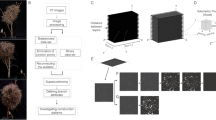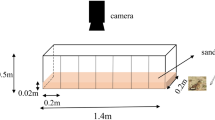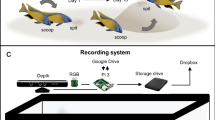Abstract
A small pufferfish, Torquigener albomaculosus, is known to construct an elaborate geometric circular structure, which has been referred to as a “mystery circle,” with a diameter of ~2 m in the sand of the seabed. We reconstructed a 3D model of this structure for the first time using a “structure from motion” (SfM) algorithm. The mystery circle constructed by the pufferfish may have potential applications for biomimetics similar to the structures constructed by termites and prairie dogs. To support the significance of its structural characteristics, it was observed that the water passing through the valley upstream always gathers in the center of the structure, regardless of the direction of water flow. Furthermore, it has the function of extracting fine-grained sand particles from the valleys and directing these to the center. Computational fluid analysis can be performed immediately using the quantified 3D data, and the structural features of the mystery circle is expected to be applied in a wide range of fields, such as architecture and engineering, via biomimetics.
Measurement(s) | 3D structure |
Technology Type(s) | SfM |
Factor Type(s) | 3D model |
Sample Characteristic - Organism | Tetraodontidae • Torquigener albomaculosus • pisces |
Sample Characteristic - Environment | sandy seabed • underwater • subtropical sea |
Sample Characteristic - Location | Amami-Oshima Island • Japan • Pacific Ocean |
Similar content being viewed by others
Background & Summary
Wild animals construct various types of structures that are adaptive to their life and reproduction. For example, termites that inhabit the African savanna use soil to construct a huge mound that reaches 10 m in height; they produce hollows and holes in these mounds to allow air ventilation, thereby keeping the internal temperature constant1. In addition, prairie dogs inhabiting the North American prairie dig vertically and horizontally extending burrows in the ground that they use for shelter and rearing offspring; these burrows have multiple entrances, some of which are chimney-shaped to improve ventilation efficiency2. In the field of biomimetics, researchers apply the principles of animal-created structures in applications useful to humans3.
The white-spotted pufferfish Torquigener albomaculosus (Pisces: Tetraodontidae) is a relatively small species that grows to ~10 cm in total total length (Fig. 1). Male T. albomaculosus individuals construct an intricate geometric circular structure, known as the “mystery circle,” with a diameter of 2 m in the sand of the seabed;4 the discovery of these structures has fascinated researchers and the general public worldwide. The male pufferfish digs the sand on the seabed with its fins and body while swimming straight ahead toward the centre from different directions, and a circular structure composed of radially aligned peaks and valleys was constructed. Finally, the male creates a maze-like pattern by flapping its anal fin on the bottom of the central zone4. Thus, the male completes the circular structure by himself. Furthermore, we discovered that the earliest stage of the mystery circle is composed of dozens of irregular depressions, which might function as landmarks for the formation of the radial patterns5. By accumulating observations of pufferfish behaviour, we were able to conduct a computer simulation including the swimming trajectory of the pufferfish extracted from video images wherein they constructed the circular structure. This simulation revealed that an elaborate circular geometric pattern is inevitably formed if the pufferfish repeats the digging behavior on the seabed using simple rules6. We also observed the reproductive behaviour of the pufferfish and found that they consistently breed in a semilunar cycle from spring to summer. Each male constructs a mystery circle and spawns with multiple females on the nest, and the male cares for the eggs alone until they hatch. Some of the elements of the circular structure, i.e., its size, symmetry, ornaments, and maze-like pattern, might be important factors in terms of female mate choice4,7.
Although data on the reproductive ecology and circle-construction behaviour of these pufferfish have been collected, many questions remain. Our interdisciplinary research currently has two themes: (i) theoretical studies on the logic of 3D-structure formation of the circular structure and (ii) ethological studies on the relationship between female mate choice and the features of the structure. To advance these studies, it is essential to collect quantitative data on the circular structure. Thus, we reconstructed 3D models of six completed mystery circles using a “structure from motion” (SfM) algorithm (Fig. 2).
“Mystery circle” constructed by a white-spotted pufferfish (Torquigener albomaculosus). 3D model displayed on a computer (a), one of the video frames used to reconstruct the 3D model (b), and a Styrofoam model output in full size created using a 3D printer and the 3D data (c) for a specific mystery circle 20160615_K13.
On the other hand, the mystery circle constructed by the pufferfish may have potential applications in biomimetics similar to the structures constructed by termites and prairie dogs. To support the importance of its structural characteristics, it has been observed that the water passing through the valley upstream always gathers in the center of the structure, regardless of the direction of water flow4. Furthermore, particle size analysis of the sand forming the mystery circle has revealed that it has the function of extracting fine-grained sand particles from the valleys arranged radially to the outside and directing them to the center (Kawase, in prep.). The field of computational fluid dynamics, which makes full use of fluid dynamics technology, engineering knowledge, and computers, will logically clarify the characteristics of the 3D structure of the mystery circle we have reconstructed here. Shameem et al. reconstructed a 3D model of a mystery circle to explore the flow features with 2D computational fluid dynamic simulations8. Since our model has already been quantified as 3D data, computational fluid analysis can be immediately performed using this data, and the structural features of the mystery circle are expected to be applied in a wide range of fields, such as architecture and engineering, via biomimetics.
Methods
During the breeding season, male T. albomaculosus individuals repeatedly construct a mystery circle, spawn with females, and care for the eggs at the circle’s central area in a semilunar cycle; the structures are completed on the same day in the same area7. Thus, six mystery circles (K1, K2, and K11–14) synchronously completed on June 15, 2016, at two locations on the seabed (depths of 13–16 m and 21–25 m, respectively) off Katetsu, Amami-Oshima Island, Japan (28° 07′ 53″ N, 129° 20′ 36″ E), were recorded in the following manner.
Each of the mystery circles was recorded using a video camera (GoPro Hero 4 Black Edition; GoPro, Inc., CA, USA) with a quality of 4 K and at 15 frames per second (fps). First, a 30-cm ruler was set on the outside of the mystery circle as an indicator of size. Next, the diver swam around the mystery circle for ~1 min from a distance of ~3 m from the center to record the entire circle and the ruler.
Having recorded the video, we reconstructed the 3D shape of each nest using the SfM algorithm. In total, ~ (900 ( = 15 fps × 60 s) video frames were acquired for each nest. The video frames were fed into the SfM software Agisoft, PhotoScan (Agisoft LLC, St. Petersburg, Russia), ver1.4.2, which was run on a PC (CPU: Intel Core i7-6900K 3.2 GHz; RAM: 128 GB; OS: Windows 7). We adjusted the parameters of the software to maximize the accuracy of the 3D shape of the reconstructed nest. If the software froze due to insufficient memory, we decimated the video frames (see Technical Validation).
Data Records
The 3D models of the six mystery circles (original-size and reduced-size files) and original video clips (Table 1) are available from figshare9. Mean and range of the outer radius, inner radius, and height difference of six completed mystery circles measured 1020 (955–1077) mm, 375 (333–411) mm, 106 (97–113) mm, respectively.
Technical Validation
In general, it is necessary to balance the trade-off between computational time and reconstruction accuracy when using the SfM algorithm. Accuracy can be maximized by increasing the number of input images captured from different viewpoints. However, in actual usage scenarios, the number of input images must be limited due to computational memory and time restrictions. In our analysis, we experimentally determined the number of input images (388–991) required for each nest. Specifically, we began with the maximum number of images and gradually reduced this number every time the software froze or the processing time was too long.
Shameem et al. reconstructed a 3D model of a mystery circle for computational fluid dynamic simulations8; however, the 3D data is not published anywhere. They used a commercially available video and obtained a sequence of 23 images for the 3D reconstruction, where estimated values of the global scale were used. In contrast, we shot original videos of mystery circles on the premise of reconstructing 3D models of mystery circles. Therefore, the absolute scale is known, and it was possible to extract sufficient and appropriate video frames from the movies shot from various directions at various angles. The six 3D models we reconstructed were the mystery circles which were completed in the same area on the same day by six males. Therefore, it was possible to compare the features in 3D models between individuals under the same conditions.
Usage Notes
Each original 3D model has a file size of ~1 GB. Therefore, a high-end computer may be required to appropriately display the files with 3D software; otherwise, the operation may be very slow, in which case a smaller processed file could be used. Alternatively, a new 3D model could be constructed using the original video clips that were used to construct the 3D models described in this study.
Code availability
No code has been provided because the 3D data were reconstructed using commercial SfM software package of Agisoft PhotoScan (Agisoft LLC, St. Petersburg, Russia), ver1.4.2.
References
French, J. R. J. & Ahmed, B. M. The challenge of biomimetic design for carbon-neutral buildings using termite engineering. Insect Science 17, 154–162, https://doi.org/10.1111/j.1744-7917.2009.01306.x (2010).
Vogel, S., Ellington, C. P. & Kilgore, D. L. Wind-induced ventilation of the burrow of the prairie-dog, Cynomys ludovicianus. J. Comp. Physiol. 85, 1–14, https://doi.org/10.1007/BF00694136 (1973).
Vincent, J. F. Biomimetics–a review. Proc. Inst. Mech. Eng. H. 223, 919–939, https://doi.org/10.1243/09544119jeim561 (2009).
Kawase, H., Okata, Y. & Ito, K. Role of huge geometric circular structures in the reproduction of a marine pufferfish. Sci Rep. 3, 2106, https://doi.org/10.1038/srep02106 (2013).
Kawase, H. et al. Discovery of an earliest-stage “mystery circle” and development of the structure constructed by pufferfish, Torquigener albomaculosus (Pisces: Tetraodontidae). Fishes 2, https://doi.org/10.3390/fishes2030014 (2017).
Mizuuchi, R., Kawase, H., Shin, H., Iwai, D. & Kondo, S. Simple rules for construction of a geometric nest structure by pufferfish. Sci Rep 8, 12366, https://doi.org/10.1038/s41598-018-30857-0 (2018).
Kawase, H., Okata, Y., Ito, K. & Ida, A. Spawning behavior and paternal egg care in a circular structure constructed by pufferfish, Torquigener albomaculosus (Pisces: Tetraodontidae). Bull. Mar. Sci. 91, 33–43, https://doi.org/10.5343/bms.2014.1055 (2014).
Shameem, A. J., Valyrakis, M. & Zare-Behtash, H. A Fluid Dynamics Approach for Assessing the Intelligent Geomorphic Design of the Japanese Pufferfish Nest. Geosciences 11, 22, https://doi.org/10.3390/geosciences11010022 (2021).
Kawase, H., Kitajima, Y. & Iwai, D. 3D model of geometric nest structure “mystery circle” constructed by pufferfish, Torquigener albomaculosus (Pisces: Tetraodontidae), figshare, https://doi.org/10.6084/m9.figshare.c.5783702.v1 (2022).
Acknowledgements
S. Kondo, K. Hosoda, and M. Shimizu of Osaka University joined the discussion on the 3D structure of mystery circles constructed by pufferfish and provided helpful comments. M. Akiyama of Meiji University and T. Sushida of Hokkaido University helped make a miniature 3D model of a mystery circle using a 3D printer. H. Hata, S. Asaba, and the Setouchi Fishery Cooperatives of Amami-Oshima Island cooperated in the underwater surveys. This research was supported by JSPS KAKENHI Grant Nos. 16H01455 and 18H04770.
Author information
Authors and Affiliations
Contributions
H. Kawase managed the whole research project, performed the underwater research in the field, and recorded the video of the mystery circles. Y. Kitajima extracted still images from video footage and reconstructed the 3D models of the mystery circles. D. Iwai oversaw the 3D model construction and verified the consistency of the 3D models.
Corresponding authors
Ethics declarations
Competing interests
The authors declare no competing interests.
Additional information
Publisher’s note Springer Nature remains neutral with regard to jurisdictional claims in published maps and institutional affiliations.
Rights and permissions
Open Access This article is licensed under a Creative Commons Attribution 4.0 International License, which permits use, sharing, adaptation, distribution and reproduction in any medium or format, as long as you give appropriate credit to the original author(s) and the source, provide a link to the Creative Commons license, and indicate if changes were made. The images or other third party material in this article are included in the article’s Creative Commons license, unless indicated otherwise in a credit line to the material. If material is not included in the article’s Creative Commons license and your intended use is not permitted by statutory regulation or exceeds the permitted use, you will need to obtain permission directly from the copyright holder. To view a copy of this license, visit http://creativecommons.org/licenses/by/4.0/.
About this article
Cite this article
Kawase, H., Kitajima, Y. & Iwai, D. 3D model of the geometric nest structure, the “mystery circle,” constructed by pufferfish. Sci Data 9, 368 (2022). https://doi.org/10.1038/s41597-022-01466-4
Received:
Accepted:
Published:
DOI: https://doi.org/10.1038/s41597-022-01466-4





